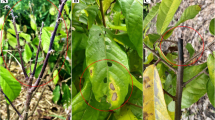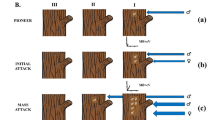Abstract
The phytophagous fruit fly Rhagoletis meigenii harbors the bacterium Wolbachia pipientis and, together with Japanese barberry, form a tri-partite symbiosis. R. meigenii is a seed predator of invasive Japanese barberry plants and is dependent on this insect-plant interaction for reproductive success. The endosymbiotic bacterium W. pipientis is a reproductive parasite known to alter the sex ratios of offspring and the fitness of infected host insects. We investigated Japanese barberry fruit for the degree of infestation by R. meigenii and characterized the Wolbachia strain infecting R. meigenii. Densities of R. meigenii in four naturalized stands of Japanese barberry revealed low numbers of fruit flies with high variability in the population densities observed among individual plants. Overall, R. meigenii infested roughly 10–20 % of the Japanese barberry fruits analyzed; fruit with two seeds (vs. one seed) were the most frequently infested. Approximately, 90 % of the R. meigenii tested positive for Wolbachia infection via PCR amplification of the Wolbachia surface protein (wsp) gene. No bacterial strain diversity was observed when comparing multi-locus sequence typing (MLST) profiles within or among five R. meigenii populations in Maine, although the MLST profile obtained from R. meigenii differed from three co-occurring Rhagoletis. The Wolbachia endosymbiont of R. meigenii is a member of the Wolbachia supergroup A and the ST-13 cluster complex.







Similar content being viewed by others
References
Aluja M, Mangan RL (2008) Fruit fly (Diptera:Tephritidae) host status determination: critical conceptual, methodological, and regulatory considerations. Annu Rev Entomol 53:473–502
Arthofer W, Riegler M, Schneider D, Krammer M, Miller WJ, Stauffer C (2009) Hidden Wolbachia diversity in field populations of the European cherry fruit fly, Rhagoletis cerasi (Diptera, Tephritidae). Mol Ecol 18:3816–3830
Augustinos AA, Santos-Garcia D, Dionyssopoulou E, Moriera M, Papapanagiotou A, Scarvelakis M, Doudoumis V, Ramos S, Aguiar AF, Borges PAV, Khadem M, Latorre A, Tsiamis G, Bourtzis K (2011) Detection and characterization of Wolbachia infections in natural populations of Aphids: is the hidden diversity fully unraveled? PLoS One 6:e28695
Baldo L, Lo N, Werren JH (2005) Mosaic nature of the Wolbachia surface protein. J Bacteriol 187:5406–5418
Baldo L, Hotopp JCD, Jolley KA, Bordenstein SR, Biber SA, Choudhury RR, Hayashi C, Maiden MCJ, Tettelin H, Werren JH (2006) Multilocus sequence typing system for the endosymbiont Wolbachia pipientis. Appl Environ Microbiol 72:7098–7110
Charlat S, Hurst GD, Mercot H (2003) Evolutionary consequences of Wolbachia infections. Trends Genet 19:217–223
Coats VC, Stack LB, Rumpho ME (2011) Maine nursery and landscape industry perspectives on invasive plant issues. Invasive Plant Sci Manag 4:378–389
Coscrato VE, Braz ASK, Perondini ALP, Selivon D, Marino CL (2009) Wolbachia in Anastrepha fruit flies (Diptera:Tephritidae). Curr Microbiol 59:295–301
Dambroski HR, Linn C, Berlocher SH, Forbes AA, Roelofs W, Feder JL (2005) The genetic basis for fruit odor discrimination in Rhagoletis flies and its significance for sympatric host shifts. Evolution 59:1953–1964
Dedeine F, Vavre F, Fleury F, Loppin B, Hochberg ME, Bouletreau M (2001) Removing symbiotic Wolbachia bacterial specifically inhibits oogenesis in a parasitic wasp. Proc Natl Acad Sci 98:6247–6252
Ehrenfeld JG (1999) Structure and dynamics of populations of Japanese barberry (Berberis thunbergii DC.) in deciduous forests of New Jersey. Biol Invasions 1:203–213
Foote RH, Blanc FL, Norrbom AL (1993) Handbook of the fruit flies (Diptera: Tephritidae) of America North of Mexico. Comstock, Ithaca, pp 323–352
Gagliardi JA, Brand MH (2007) Connecticut nursery and landscape industry preferences for solutions to the sale and use of invasive plants. HortTechnology 17:39–45
Haine ER, Pickup NJ, Cook JM (2005) Horizontal transmission of Wolbachia in a Drosophila community. Ecol Entomol 30:464–472
Harmon E (2006) Introduced species summary project: Japanese barberry (Berberis thunbergii). Introduced species summary project, Center for Environmental Research and Conservation. Columbia University, New York, NY http://www.columbia.edu/itc/cerc/danoff-burg/invasion_bio/inv_spp_summ/Berberis_thunbergii.htm Accessed 10 May 2012
Heath BD, Butcher RD, Whitfield WG, Hubbard SF (1999) Horizontal transfer of Wolbachia between phylogenetically distant insect species by a naturally occurring mechanism. Curr Biol 9:313–316
Hedges LM, Brownlie JC, O’Neill SL, Johnson KN (2008) Wolbachia and virus protection in insects. Science 322:702
Heubner CD, Olsen C, Smith HC (2007) USDA invasive plants field reference guide: an ecological perspective of plant invaders of forests and woodlands. U.S. Department of Agriculture, Forest Service, Northern Research Station, Eastern Region. Northeastern Area State and Private Forestry, Newtown Square, PA
Hosokawa T, Koga R, Kikuchi Y, Meng X, Fukastu T (2010) Wolbachia as a bacteriocyte-associated nutritional mutualist. Proc Natl Acad Sci 107:769–774
[IPANE] Invasive Plant Atlas of New England (2012) Berberis vulgaris L. University of Connecticut, Storrs, CT (http://www.eddmaps.org/ipane/ipanespecies/shrubs/Berberis_vulgaris.htm) Accessed 12 May 2012
Jaenike J (2007) Spontaneous emergence of a new Wolbachia phenotype. Evolution 61:2244–2252
Jolley K, Chan MS, Maiden MCJ (2004) mlstdbNet- distributed multi-locus sequence typing (MLST) databases. BMC Bioinforma 5:86
Kikuchi Y, Fukatsu T (2003) Diversity of Wolbachia endosymbionts in Heteropteran bugs. Appl Environ Microbiol 69:6082–6090
Lubell JD, Brand MH, Lehrer JM, Holsinger KE (2009) Amplified fragment length polymorphism and parentage analysis of a feral barberry (Berberis thunbergii DC.) population to determine the contribution of an ornamental landscape genotype. Hortscience 44:392–395
Maier CT (2005) First records of alien insects in Connecticut (Orthoptera: Tettigoniidae; Coleoptera: Buprestidae; Chrysomelidae; Diptera: Rhagionidae, Tephritidae; Hymenoptera: Megachilidae). Proc Entomol Soc Wash 107:947–959
Markov AV, Laxebny OE, Goryacheva II, Antipin MI, Kulikov AM (2009) Symbiotic bacteria affect mating choice in Drosophila melanogaster. Anim Behav 77:1011–1017
Mercot H, Poinsot D (2008) Infection by Wolbachia: from passengers to residents. C R Biol 332:284–297
Ostergard H, Hamback PA, Ehrlen J (2007) Pre-dispersal seed predation: the role of fruit abortion and selective oviposition. Ecology 88:2959–2965
Prokopy RJ, Papaj DR (2000) Behavior of flies of the genera Rhagoletis, Zonosemata, and Carpomya. In: Fruit Flies (Tephritidae): phylogeny and evolution of behavior. CRC press LLC, Boca Raton, pp 219–252
Renvoise A, Merhej V, Georgiades K, Raoult D (2011) Intracellular Rickettsiales: Insights into manipulators of eukaryotic cells. Trends Mol Med 17:573–583
Rokas AJ, Atkinson J, Nieves-Aldrey L, West SA, Stone GN (2002) The incidence and diversity of Wolbachia in gallwasps (Hymenoptera: Cynipidae) on oak. Mol Ecol 11:1815–1829
Saridaki A, Bourtzis K (2010) Wolbachia: more than just a bug in insects’ genitals. Curr Opin Microbiol 13:67–72
Schuler H, Arthofer W, Reigler M, Bertheau C, Krumbock KK, Vogt H, Teixeira LAF, Stauffer C (2011) Multiple Wolbachia infections in Rhagoletis pomonella. Entomol Exp Appl 139:138–144
Serbus LR, Casper-Lindley C, Landmann F, Sullivan W (2008) The genetics and cell biology of Wolbachia-host interactions. Ann Rev Genet 42:683–707
Silander JA Jr, Klepeis DM (1999) The invasion ecology of Japanese barberry (Berberis thunbergii DC.) in the New England landscape. Biol Invasions 1:189–201
Sim SB, Mattsson M, Feder JL, Cha DH, Yee WL, Goughnour RB, Linn CE Jr, Feder JL (2012) A field test for host fruit odour discrimination and avoidance behaviour for Rhagoletis pomonella flies in the western United States. J Evol Biol 25:961–971
Sintupachee S, Milne JR, Poonchiasri S, Baimai V, Kittayapong P (2006) Closely related Wolbachia strains within the pumpkin arthropod community and the potential for horizontal transmission via the plant. Microb Ecol 51:294–301
Siozios S, Sapountzia P, Iannidis P, Bourtzis K (2008) Wolbachia symbiosis and insect immune response. Insect Sci 15:89–100
Smith JJ, Bush GL (1997) Phylogeny of the Genus Rhagoletis (Diptera: Tephritidae) inferred from DNA sequences of mitochondrial cytochrome oxidase II. Mol Phylogenet Evol 7:33–43
Soldaat LL, Auge H (1998) Interactions between an invasive plant, Mahonia aquifolium, and a native phyotphagous insect, Rhagoletis meigenii. In: Plant invasions: ecological mechanisms and human responses. Backhuys Publishers, Leiden, pp 347–360
Teixeira L, Ferreira A, Ashburner M (2008) The bacterial symbiont Wolbachia induces resistance to RNA viral infections in Drosophila melanogaster. PLoS Biol 6:e1000002
[USDA] U.S. Department of Agriculture, 2007 Census of Agriculture (2009) 2009 census of horticultural specialities. U.S. Department of Agriculture, Washington, DC, p 536
[USDA ARS] U.S. Department of Agriculture, Agricultural Research Service (2012) Plant hardiness zone map: Maine. PRISM Climate Group, Oregon State University, Corvalis, Oregon. http://planthardiness.ars.usda.gov/PHZMWeb/ Accessed 15 April 2012
[USDA NCRS] U.S. Department of Agriculture, Natural Resources Conservation Service (2012) The PLANTS Database. National Plant Data Center, Baton Rouge, Louisiana. http://plants.usda.gov Accessed 8 Jan 2012
Vavre F, Fleury F, Lepetit D, Fouillet P, Bouletreau M (1999) Phylogenetic evidence for horizontal transmission of Wolbachia in host-parasitoid associations. Mol Biol Evol 16:1711–1723
Werren JH (1997) Biology of Wolbachia. Annu Rev Entomol 42:587–609
Werren JH, Zhang W, Guo LR (1995) Evolution and phylogeny of Wolbachia: reproductive parasites of arthropods. Proc R Soc Lond Ser B 261:55–63
Werren JH, Baldo L, Clark ME (2008) Wolbachia: master manipulators of invertebrate biology. Nat Rev Microbiol 6:741–751
White JA (2011) Caught in the act: rapid, symbiont driven evolution. Bioessays 33:823–829
Winkler IS, Mitter C (2008) The phylogenetic dimension of insect-plant interactions: a review of recent evidence. In: Specialization, speciation, and radiation: the evolutionary biology of herbivorous insects. Univ. of California Press, Berkeley, pp 240–263
Zouhar K (2008) Berberis thunbergii. In: Fire effects information system, U.S. Department of Agriculture, Forest Service, Rocky Mountain Research Station, Fire Sciences Laboratory. http://www.fs.fed.us/database/feis/plants/shrub/berthu/introductory.html Accessed 17 November 2011
Zug R, Hammerstein P (2012) Still a host of hosts for Wolbachia: analysis of recent data suggests that 40 % of terrestrial arthropod species are infected. PLoS One 7:e38544
Acknowledgments
This research was supported by U.S. Department of Agriculture CSREES grants no. 2009-38914-19786 and 2010-38914-20996 to M.E.R., and both a 2010 LL Bean Scientific Research Fellowship in Acadia National Park by the Friends of Acadia National Park (http://www.friendsofacadia.org/) and a 2010 Maine Agricultural and Forest Experiment Station Integrated Pest Management Graduate Student Grant to V.C.C. This is Maine Agricultural and Forest Experiment Station Publication Number 3305, Hatch Project no. ME08362-07H.
Author information
Authors and Affiliations
Corresponding author
Rights and permissions
About this article
Cite this article
Coats, V.C., Stack, P.A. & Rumpho, M.E. Japanese barberry seed predation by Rhagoletis meigenii fruit flies harboring Wolbachia endosymbionts. Symbiosis 59, 145–156 (2013). https://doi.org/10.1007/s13199-013-0223-5
Received:
Accepted:
Published:
Issue Date:
DOI: https://doi.org/10.1007/s13199-013-0223-5




